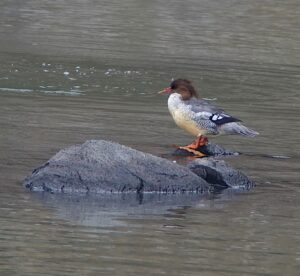EAAFP Small Grant Fund project by
Nial Moores,
Director, Birds Korea and IUCN SSC Threatened Waterfowl Specialist Group

©Nial Moores
Sitting low in the water, close to the river bank, a Scaly-sided Merganser rests, half-hidden by the shade of an overhanging tree and by a line of jagged black rocks. Waking, the bird moves away from us quietly, and is soon joined by another and then another. Seen well, the details of each of these birds is exquisite: jagged crests, bright fire-red bills, and flanks with black and white fish-scales that mirror perfectly the ripples and reflections on the water.
The Scaly-sided Merganser is a species that comes to Korea from the wildest river forests of East Asia, from summers in remote mountain valleys shared with the Siberian Tiger. They are shy, doing all they can to keep their distance from that most fearful of predators: people.
They need fish to survive, caught in a series of shallow dives, often close to the river bank or in riffles where the flow is fastest. Each autumn, as the rivers further north freeze-over they have no choice but to move south; to spend the winter in landscapes that must now seem almost unrecognizable to them – curving, gurgling rivers dammed and dredged and straightened; cars and camp sites on shingle banks; formerly dark, silent forested banks spotted with private houses and coffee shops and restaurants playing the latest K-Pop music; quiet river bends, once safe refuges, made ever-more accessible to fast-moving packs of cyclists and hikers on paved highways, apparently oblivious to the exceptional biodiversity around them. Fewer and fewer places remain in the Republic of Korea (ROK) for the Scaly-sided Merganser, and for many of the species that share the same habitat: ground-nesting Long-billed Plovers and tree-nesting Mandarin Ducks, River Otters and freshwater turtles and endemic fish species. A whole suite of species confined to ever-smaller spaces; once connected ecosystems now fragmented.
What can be done to slow down and then to reverse this decline in biodiversity, along Korean rivers and indeed in almost all the habitats on our increasingly degraded planet?
Birds Korea is an active member of the East Asian-Australasian Flyway Partnership (EAAFP) Scaly-sided Merganser Task Force. We are small, but like so many environmental NGOs around the world, we do all we can to support decision-makers with best science; and to accelerate progress toward sustainability by offering solutions clarified through tailor-made plans and designs. For the Scaly-sided Merganser, this means first finding where the species can still survive, and then identifying the most efficient ways to reduce disturbance, river stretch by river stretch. In a world where quick economic returns are valued over sustainability, this means identifying ways in which local communities can genuinely benefit from conservation, be it through eco-tourism, local branding or subsidy support, as well as in helping build local pride.
There is, as far as we know, still no fully protected stretch of river anywhere in the ROK which is 100% free from the threat of river-works and increasing disturbance. Nonetheless, 2022 has seen substantial progress.
Funded by Yeoncheon County, we have been able to build on research in the Yeoncheon Imjin River Biosphere Reserve – a core area for the species during migration - to identify key stretches, to propose mitigation measures, and to raise awareness. And thanks to a small grant from the EAAFP and funding from the Hanns Seidel Foundation office in Seoul, we were also able to conduct our third national winter survey of the Scaly-sided Merganser, finding 175 individuals nationwide – about 4% of the estimated world population. We were also able to learn more about their migration strategy, counting 215 along three rivers in mid-November; and to hold the first workshop on the species, with wonderful activists sharing their insights. The EAAFP small grant also provided vital support for in-field training in identification and in counting, and in the production of an educational pamphlet
Much remains to be done, of course. But the information gaps are closing, and more and more people now feel their deep connection to this wary, fish-patterned bird, to this endangered spirit of the river wild.
The project was funded through the 2022 EAAFP WG/TF Small Grant Fund. View the report, Click here.





